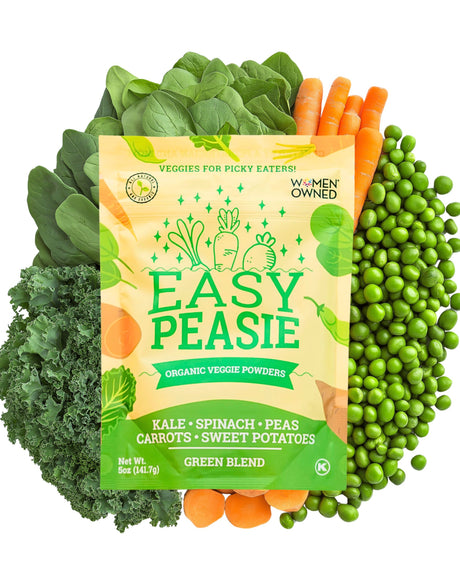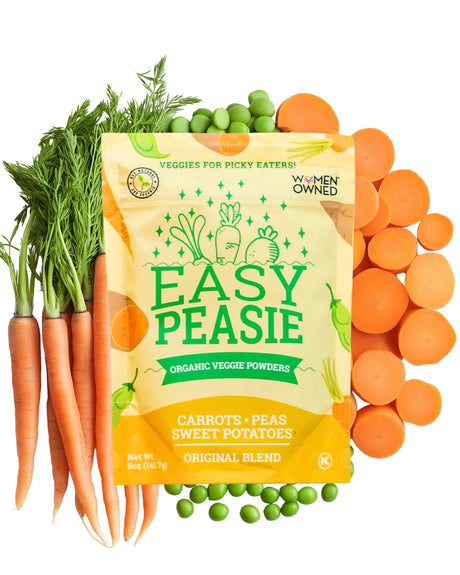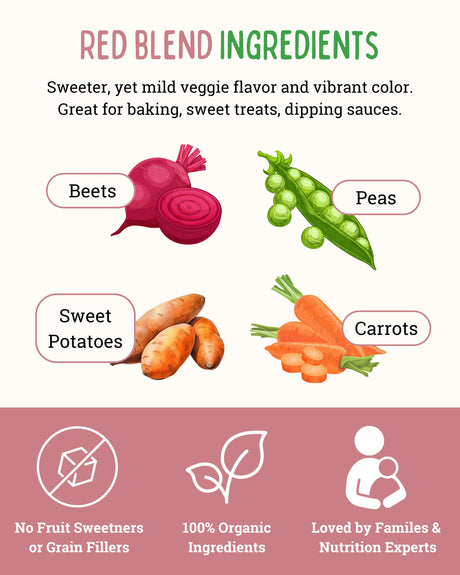The age-old battle of broccoli versus tantrums. It's a scene many parents know all too well.
The dinner table standoff: a plate of untouched greens, a child's resolute face, and the growing concern about whether they're getting the nutrients they need.
Why do so many kids turn up their noses at the very sight of vegetables? Is it the color? The texture? Or perhaps something deeper rooted in their taste buds?
Whatever the reason, it's a challenge that has left many parents scratching their heads.
But fear not, for this isn't a battle you have to face alone. Together, we'll delve into the mysteries behind these veggie aversions and, more importantly, explore actionable solutions to turn those frowns upside down.
Whether you're dealing with a toddler who's just discovering their taste preferences or an older child stuck in their veggie-avoiding ways, there's hope on the horizon. Let's embark on this journey to make vegetables a beloved part of our children's meals.
Understanding the Veggie Aversion
Developmental Perspective:
Did you know that children have more taste buds than adults? It's true! This means they can detect flavors, especially bitter ones, more intensely.
Vegetables, particularly greens, can have a bitter undertone that might be subtle to us but overpowering for them. As children grow, their taste buds mature and become less sensitive, allowing them to appreciate a wider range of flavors.
It's not that they're being fussy on purpose; they genuinely experience tastes differently. So, when your little one scrunches up their face at the first bite of Brussels sprouts, remember, they might be getting a stronger burst of bitterness than you do.
Texture Troubles:
Beyond taste, the texture can be a significant hurdle. Think about it: the squishiness of cooked zucchini, the graininess of cooked spinach, or the stringiness of celery.

For some kids, it's not the flavor but the feel of the vegetable in their mouth that turns them off. Children are still exploring textures, and what might seem mundane to us can be incredibly pronounced for them.
It's essential to recognize this and get creative. Maybe they'd prefer their carrots crunchy instead of steamed or their spinach blended into a smoothie rather than wilted.
Past Experiences:
Ever had a food you disliked because of one bad experience? Kids are no different. If they've had an unpleasant encounter with a vegetable—say it was overcooked, too bitter, or made them feel unwell—they might be hesitant to try it again.
It's a protective mechanism; our brains are wired to avoid foods that we associate with negative experiences. The key is to reintroduce the vegetable in a new, positive context, ensuring it's well-prepared and perhaps paired with something they love.
Over time, with repeated positive exposures, the old memory can fade, making room for a new, tastier one.
The Importance of Vegetables in a Child's Diet
Nutritional Value and the Role of Vegetables in Overall Health:
Vegetables are nature's multivitamins. Packed with essential nutrients, they play a pivotal role in ensuring optimal health for our little ones.
From the iron in spinach that supports cognitive development to the vitamin C in bell peppers that boosts immunity, each vegetable brings its unique set of benefits to the table.

Moreover, they're rich in dietary fiber, which aids digestion and promotes gut health. By incorporating a variety of vegetables into a child's diet, we're not just filling their bellies but fueling their bodies with the nutrients they need to grow, learn, and thrive.
Long-Term Benefits of Cultivating a Taste for Vegetables Early On:
Developing a palate for vegetables in childhood can set the stage for lifelong healthy eating habits. Children who are exposed to and enjoy a wide range of vegetables are more likely to carry those preferences into adulthood.
This not only reduces their risk of chronic diseases like obesity, heart disease, and type 2 diabetes but also fosters a positive relationship with food. They learn to see vegetables not as a chore to be endured but as a delicious and integral part of their meals.
By nurturing this appreciation early on, we're giving them a gift that goes beyond the dinner table—a foundation for a lifetime of health and well-being.
Strategies for Introducing Vegetables
Start Small:
It's all about baby steps when it comes to introducing new foods, especially vegetables. Instead of overwhelming a child with a large serving, begin with a small, manageable portion.
This approach reduces the pressure and makes the experience less daunting. Over time, as they become more accustomed to the taste and texture, you can gradually increase the quantity.
Mix and Match:
One of the best ways to introduce vegetables is by pairing them with foods your child already loves. This could be as simple as adding some finely chopped veggies into their favorite dip or sandwich. The familiar flavors can act as a comforting bridge to the new taste, making the experience more enjoyable.
Fun Presentations:
We eat with our eyes first, and this is especially true for kids. Turning vegetables into fun shapes, creating colorful salads, or designing playful veggie faces on a plate can make a world of difference.
When vegetables are presented in an exciting and visually appealing manner, children are more likely to be curious and give them a try.
Incorporate in Familiar Dishes:
Another effective strategy is to seamlessly blend vegetables into dishes your child already enjoys. Think spinach in smoothies, grated zucchini in pasta sauce, or bell peppers on a pizza.

By incorporating veggies into beloved meals, you're not only boosting the nutritional value but also introducing them in a way that feels less foreign and more palatable.
Alternative Solutions for Veggie Intake
Veggie Powders:
In today's innovative food landscape, there are products designed specifically to address the age-old veggie challenge. Enter veggie powders, like EasyPeasie.
These blends are a godsend for parents, allowing them to sprinkle nutrition right into their child's favorite meals. Whether it's mixed into sauces, batters, or even just a sprinkle on top, these powders ensure that kids get the essential nutrients from vegetables without even realizing it.
Veggie-Infused Snacks:
Who said snacks can't be both tasty and nutritious? There's a growing market of snacks that cleverly incorporate vegetables as their main ingredients.
From veggie straws to beet chips, these snacks offer a crunch kids love, with the added bonus of vegetable nutrition. It's a win-win for parents looking to sneak in some extra veggies throughout the day.
Juices and Smoothies:
For those kids who might not be keen on munching on raw veggies, drinking them might just be the answer. Blending vegetables with sweet fruits can mask the taste, making for a delicious and nutritious drink.
Think spinach paired with mango or carrots with oranges. Not only do these combinations offer a burst of flavor, but they also provide a powerhouse of vitamins and minerals.
Smoothies, in particular, can be a breakfast staple, ensuring kids kickstart their day with a good dose of veggies.

Involving Kids in the Cooking Process
Making Mealtime a Team Effort:
There's something magical about the act of creating, especially when it comes to food. When children are involved in the cooking process, they form a connection with the meal.
It's no longer just a plate of food; it's something they've had a hand in making. This sense of ownership and pride can often translate into a willingness to try what they've helped prepare. After all, tasting the fruits of their labor can be a rewarding experience!
Fun in the Kitchen:
Cooking doesn't have to be a chore; it can be a delightful bonding activity. Think of simple tasks like washing vegetables, stirring the pot, or even just setting the table.
For slightly older kids, measuring ingredients or using cookie cutters can be both educational and fun.
Making veggie pizzas? Let them choose and arrange their toppings. Preparing a salad? They can tear the lettuce and sprinkle the add-ins.
The key is to make the experience enjoyable and interactive. Not only does this foster a love for cooking, but it also paves the way for them to appreciate a variety of foods.

Setting a Positive Example
Leading by Example:
Children are keen observers, often mirroring the behaviors and preferences of those around them. When they see their parents or older siblings relishing a plate of colorful veggies, it sends a powerful message.
It's not just about telling them that broccoli is good for them; it's about showing genuine enjoyment while munching on it. This observational learning can subtly encourage them to give that crunchy carrot or juicy tomato a try.
After all, if mom or big brother loves it, there must be something delightful about it!
Creating a Joyful Dining Atmosphere:
Mealtime should be a pleasant experience, not a battleground. Pressuring kids to finish their greens or using dessert as a bargaining chip can create negative associations with food.
Instead, focus on fostering a relaxed and positive environment at the dining table. Celebrate the small victories, like trying a new vegetable, without making a big fuss.
Remember, it's okay if they don't love every veggie on their plate. The goal is to cultivate curiosity and openness, allowing them to discover their own palate at their own pace.
Final Thoughts
The Virtue of Patience:
Navigating the world of children's nutrition, especially when it comes to vegetables, is no small feat. It's essential to remember that every child is unique, and their journey to embracing veggies will be equally individual.
Some might take to greens instantly, while others might need a little more coaxing. But with patience and persistence, the path to a veggie-loving kiddo becomes smoother.
It's all about celebrating the small wins and understanding that setbacks are just part of the process.
Stay Curious and Keep Innovating:
The world of nutrition is vast, and there's always something new to learn. Parents are encouraged to stay informed about the latest research and trends.
But more than that, it's about getting creative in the kitchen. Whether it's trying a new recipe, presenting veggies in a fun shape, or incorporating them into a beloved dish, the possibilities are endless.
The key is to keep experimenting, keep introducing, and most importantly, keep the mealtime experience joyful and stress-free. After all, the journey to cultivating a love for vegetables is as much about the memories made as it is about the nutrients consumed.













